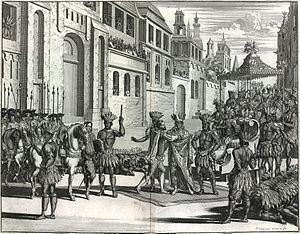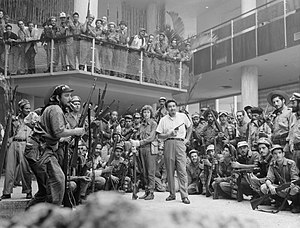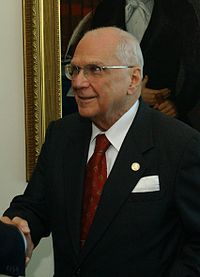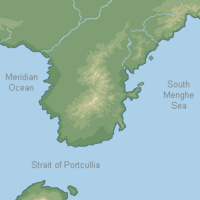Innominada
People's Republic of Innominada República Popular de Innominada | |
|---|---|
| 1967–2015 | |
| Motto: Juntos, Venceremos (Anglian: "Together, we will overcome") | |
 Map of the four modern-day states that formerly comprised Innominada | |
| Capital | Salvador |
| Common languages | Sylvan Kedi Argentan |
| Demonym(s) | Innominadan |
| President | |
• 1967-1983 | Sosimo Capote |
• 1983-1992 | Victor Martínez |
• 1992-2000 | Vicente Arellano |
• 2000-2013 | Hernando Santángel |
• 2013-2015 | Pablo Bienvenida |
| Legislature | Popular Assembly |
| History | |
• Sylvan colonization | 3 November 1499 |
• Established | 4 August 1967 |
• Partitioned | 15 June 2015 |
| Area | |
| 2013 | 1,129,325 km2 (436,035 sq mi) |
| Population | |
• 2013 | 83,101,242 |
| Currency | Innominadan Dolar (IND) |
| Today part of | Argentstan Isla Diamante People's Republic of Innominada Republic of Innominada |
Innominada is the name of a former country in South Hemithea. The term is also applied to the Innominadan Peninsula, a body of land jutting southward from the continent of Hemithea into the Strait of Portcullia. Today, the peninsula is occupied by four countries, which were divided following Innominada's collapse in 2014: the People's Republic of Innominada, the Republic of Innominada, Isla Diamante, and Argentstan.
Prior to colonization, the Innominadan peninsula was home to a string of wealthy merchant kingdoms along the southeast coast, with semi-nomadic tribes scattered throughout the east. Sylvan explorers arrived in 1499 and conquered most of the territory by 1543; in 1671 they annexed the Argentan Phan Dok Sultanate, bringing the colony to its current boundaries. Sylvan authorities ran Innominada as an extractive colony, relying on indigenous slaves to work a vast network of mines and plantations. In the process, they established a lasting racial hierarchy separating Creoles, Mestizos, and indigenous peoples.
Syndicalist rebels overthrew the Sylvan-backed commonwealth government in 1967, redistributing farmland and handing control of factories to democratic unions. For a time, the People's Republic of Innominada was the wealthiest Socialist state in Hemithea, but by the 1990s, lackluster economic reforms and rising ethnic tensions led to political instability and erratic foreign policy.
In 2015, following a civil war, the country was partitioned into three states. Isla Diamante was temporarily placed under Sylvan control, and later transferred to a Sylvan-backed commonwealth government. The Menghe-backed Republic of Innominada was carved out of the provinces running along the South Menghe Sea and Strait of Portcullia, bordered inland by the Sierra Verde mountains. In the northwest of the country, Maverica established the People's Republic of Innominada, a rump state claiming to represent the deposed prewar government. The most recent change came on June 6th, 2018, when three provinces of the Republic of Innominada were carved off to form the state of Argentstan.
Names
When the first Sylvan explorers arrived on the west coast of Hemithea, they labeled the region Terra Innominada, literally "Unnamed Land," on their maps and in their records. Originally, they applied the name to the entire continent, to express its unknown status and unclear extent. Although it was likely intended as a temporary label, pending a royal decision on whether to name the new land after the King or one of the lead explorers, the name stuck, and by 1510 it was recognized as the official name of Sylva's colonial possessions along the west coast.
In Menghean and its related languages, the region is known as Wŏlnam (월남 / 越南), for its location south (and west) of the Wŏl river. As the Wŏl river is well inside Menghe, forming the boundary between Hwangjŏn Province and the Lakkian Semi-Autonomous Province, the label initially included the Menghean Southwest, which until the 14th century was outside of Menghean control. After Menghe expanded its control over the area under the Yi dynasty, and later under the Myŏn dynasty, the term Wŏlnam was reinterpreted to encompass only the lands southwest of Menghean territory, even though the boundary currently lies at the Sama river.
History
Early history
Paleontologists believe that Innominada was the site of the first human crossing out of the continent of Meridia, approximately 75,000 years ago. During that time, a pronounced ice age lowered sea levels and exposed a large portion of the Innominadan Shelf, reducing the gap between what are now Innominada and Khalistan. This was not a true land bridge, as there was still a roughly 100-kilometer sea gap in between; early human crossings likely involved some degree of sea travel. From there, early humans fanned out through the rest of Hemithea, and later made a similar crossing to Casaterra.
The first organized states on the peninsula formed much later, during the 2nd century CE. These small kingdoms were scattered along the southeast coast and up the Argentan River Valley, and they relied primarily on fishing, rice farming, and cattle herding. Even by the 12th Century, most of these states took a mandala form, with unclear borders and overlapping authority to major tribute centers along the coasts and rivers. During Menghe's Kang dynasty, the coastal kingdoms benefited from the growth of a coastal trade network running from Dayashina and Khalistan, and prospered as stop-over points along the main shipping route.
Eastern Sultanates
The active trade network brought the coastal kingdoms in contact with merchants from West Meridia. During the 7th century CE, Shahidism emerged as a major religion in what is today Ummayah, and Taleyan merchants brought the new religion to Hemithea. At first its following was mainly limited to the coastal cities, but after local rulers converted to Shahidism, it gained status as a state religion. By the end of the 11th century, most locals in the coastal kingdoms had converted to Shahidism, though particularly in rural areas they fused it with traditional customs, festivals, and styles of dress.
In 1292, under the reign of the Chŏnsun Emperor, the Yi dynasty launched the Southwestern Expedition, a series of wars to bring the Lakkian, Argentan, and Kedi tribute kingdoms under Menghean control. By the end of these campaigns in 1317, the Yi dynasty exerted direct rule over all of East and Southeast Innominada, and ruled over the northwest through a tribute agreement with the local tribes. The period of Yi rule brought major cultural influences from Menghe, particularly in vocabulary, place names, customs, and styles of dress. Yet local culture continued to flourish, and Shahidism remained the dominant religion.
Sylvan rule
The first Sylvan explorers arrived on the west coast of what is today Innominada in 1499. There, they set up a small number of coastal settlements, where they could take on supplies and trade with the natives. From there, they moved along the Hemithean coast, landing in the Menghean port of Bokju (today Giju) in 1502. In addition to lightweight muskets and Christian teachings, the new arrivals brought the Yersinia pestis bacterium, previously absent in Hemithea. The resulting plague killed half of Menghe's population, toppling the Yi dynasty and opening the way for the Eastern Caliphates to break away from Menghean control once again. Their independence, however, would be short-lived: knowing loosely of the plague's transmission by flea-infested animals, Sylvan colonists released plague-infested rats and feral pigs into central Innominada, then sent columns of conquistadors inland to take control in the ensuing chaos. Between 1524 and 1533, they conquered the Kedi-populated Sultanates in the south; between 1664 and 1671, they conquered the Argentan Phan Dok Sultanate, extending the Innominadan colony to its 2014 borders.
Sylvan rulers treated Innominada as an extractive colony, using gold mining in the Sierra Verde mountains and plantation agriculture elsewhere to finance military expansion plans at home. Yet the institutions they set up differed by region, with lasting social and cultural consequences. In the west, where the indigenous population was sparse, Sylvan colonists displaced the native tribes eastward and set up independent farms. Southeast of the Sierra Verde, where the population was denser, they relied more heavily on local labor, enslaving the Kedi peoples and using them as plantation and mining labor. The conquistadors, many of whom were veterans of religious wars in Casaterra, forcibly converted most of the population to Catholicism, and over time, intermarriage and sexual violence produced a large mixed (or Mestizo) population. After adding the Phan Dok Sultanate to the colony in 1671, Sylvan authorities imposed an even more extreme form of this system, tying the local peasants to the land as serfs and forbidding intermarriage between Creoles and local Argentans. The resulting social pyramid of Creoles, Mestizos, and indigenous people was burned deep into the fabric of Innominadan society.

Innominada gained autonomy from Sylva in 1883, though it remained part of a Commonwealth alliance with close ties to the metropol. The new government abolished serfdom in 1885, but it retained a system of apartheid in the northeast, and in practice most Argentans and Kedi continued to work on massive Creole-run estates as tenant laborers.
In the wake of the Pan-Septentrion War, Innominada experienced a modest economic boom. Menghe and Maverica, its main economic competitors, had been devastated by war, while its west coast was spared the worst of the destruction when Menghean forces withdrew prematurely in 1944. Innominada also received generous economic support from Sylva, and benefited from low tariffs in the immediate postwar era. Most of its newfound growth came from the textiles sector, as low-wage spinning mills linked up with existing cotton plantations, but growth also spilled over into other areas of light industry.
People's Republic of Innominada
Rapid economic growth in the postwar era relied on poor labor conditions, which by the early 1960s had given way to deep social unrest. Inspired by the success of recent Communist revolutions in Maverica and Menghe, the underground People's Revolutionary Front - Syndicalist (FRG-S) began smuggling arms across the northern border to support the armed overthrow of the state. Fighting broke out in 1963, and it quickly spread from the cities to the countryside, where Argentan and Kedi rebels staged uprisings against large landowners. The FRG-S formed an alliance with the indigenous rebels, promising land reform and racial equality in return for minority cooperation in a unified state. Despite Sylvan military support, the Prime Minister surrendered to the revolutionaries on August 4th, 1967.
The victorious FRG-S ruled Innominada as a one-party state. It dissolved the large plantation estates, allowing tenant villages to either farm the land in common or break it into equal household plots. Factories and workshops were reorganized along syndicalist lines, with workers voting on economic decisions in conjunction with state-appointed managers. General-Secretary Sosimo Capote (r. 1967-1983), himself a Mestizo, abolished the apartheid system and appointed Kedis and Argentans to high positions in government. Official Party doctrine in this period held that religious and racial boundaries were a bourgeois tool to divide the workforce, and advocated for inter-communal harmony. Yet as part of this doctrine, the FRG-S refused to institute affirmative action quotas or carve out autonomous provinces, and it organized campaigns to promote atheism in majority-Shahidic areas.
As time passed, the FRG-S increasingly aligned itself with urban, Creole interests. Vicente Arellano, President and General-Secretary from 1992 to 2000, responded to growing opposition in the west by gradually reshaping Party ideology to include nationalist and religious appeals. To revitalize the stalled economy, he also allowed private businessmen to run small and medium enterprises as long as they allowed workers to vote on all key management decisions. These decisions won him support from Sylvan Creoles, but alienated Argentans, Kedis, and some Mestizos, as the Party continued its anti-Shahidism campaigns and instituted Sylvan as the national language.
In the 2000 presidential election the FRG-S instituted another political reform, allowing opposition parties to run for office. Through ballot stuffing and other irregularities, the ruling party ensured that Hernando Santángel, its hand-picked choice, won the presidency. Like his predecessor, Santángel was a pure-blood Creole who viewed Innominada as a culturally Christian state, but he brought this ideology into the open. After polling ahead of the 2004 election suggested a closer margin of victory, Santángel responded by mobilizing Shahidophobic rhetoric against the Kedi and Argentans, setting off a chain reaction of violence which culminated in the Christmas Riots of 2004. Creole nationalists continued to stage isolated beatings of Kedi and Argentans well into the 2010s, while state security forces carried out raids on mosques and indigenous neighborhoods. Argentan separatists responded with a string of terrorist attacks, fueling a cycle of tit-for-tat ethnic violence.
Civil war and partition
Hernando Santángel passed away in 2013, leaving the reins of power to his appointed successor, Vice President Pablo Bienvenida. In response to widespread protests about the undemocratic transition, the FRG-S announced that a special election would take place on March 9th, 2014. With the economy stagnant and racial tensions peaking, Bienvenida's popularity tumbled ahead of election day, and after initial exit polls showed the moderate opposition candidate Hernan Martínez in the lead, the FRG-S halted ballot counting and announced a victory for Bienvenida. Reform supporters responded by staging violent demonstrations in the streets, and a member of the Presidential Guard assassinated Bienvenida in retaliation for a deadly attack on protesters. Opposition supporters in the south rallied around Hernan Martínez, who had declared himself the rightful winner, and Argentan and Kedi separatists staged uprisings throughout the northwest.

In response to a string of pirate attacks in the Strait of Portcullia, Sylvan forces occupied Isla Diamante and declared their intention to annex it as a military base. This move deeply provoked Menghe, which launched a large-scale invasion on September 21st, 2014. As demoralized, worn-out government forces crumbled before the Menghean advance, Maverica moved troops into the northwest of the country to prop up the Innominadan regime. With the help of a last-minute diplomatic intervention from Hallia, the two powers were able to narrowly avoid escalation into a Third World War, and they agreed to partition Innominada into Northwest and Southeast zones. The new borders followed existing provincial boundaries, and also placed the Sierra Verde range between the two countries as a natural barrier.
At first, Menghe administered the Republic of Innominada with relatively light imposition, allowing Prime Minister Hernan Martínez's government to set its own political and economic policy. Even under the leadership of a moderate Mestizo, however, ethnic tensions continued to simmer. In late 2016, the Menghean Special Liaison to Innominada concluded that the policies of ethnic consociationalism and political autonomy were not working, and authorized a referendum on Argentstani independence. After the secessionist victory triggered another string of riots, which the Martínez government appeared to back, Menghean troops stationed in the country launched an organized crackdown. Argentstan's secession was allowed to move forward, with a continued Menghean presence in the country, and the Republic of Innominada's government was reorganized into a single-party regime with more active Menghean interference.
Geography

The Innominadan Peninsula juts southward from the continent of Hemithea. Its west coast borders the Meridian Ocean, and its east coast borders the South Menghe Sea. To the south, between Innominada and Khalistan, runs the Strait of Portcullia, a roughly 500-kilometer stretch of water linking the two oceans. The strait's name comes from the island of Portcullia, named by Sylvan explorers in 1501. During the time of the Menghean Sŭng and Yi dynasties, this made Innominada a critical stop-over point on the voyage from Hemithea to Meridia. Today, it makes the peninsula a strategic bastion for controlling the movement of trade ships and warships between the Meridian Ocean and the South Menghe Sea.
The Sierra Verde mountains divide the peninsula roughly into east and west. Prior to Sylvan colonization, the mountains also formed a barrier between the densely populated farming communities of the South Menghe Sea coast and the sparse, semi-nomadic tribes of the West. After settlement, Sylvan Creoles brought the west side population density to a higher level, but the proportion of indigenous and mixed people varies with pre-colonial population density. Today, the Sierra Verde mountains also roughly follow the border between Argentstan and the Republic of Innominada, on the one hand, and the People's Republic of Innominada, on the other. Although the border was chosen based on existing Innominadan provincial boundaries, this choice was partly intended to create a natural obstacle between the two sides and discourage future conflict.
Most of the peninsula has a tropical savanna climate, with areas of tropical monsoon climate along the lower east coast. There is a small stretch of tropical rainforest climate in the south, where humid winds rising over the mountains drop heavy rainfall. Originally, the peninsula was heavily forested, but large swaths of rainforest were clear-cut during the colonial area to support additional plantation land. Today much of the remaining jungle is in the Sierra Verde range.
Prior to its division, Innominada bordered two countries by land: Maverica to the north, and Menghe to the northeast. Of the four republics existing after 2018, Maverica borders only the People's Republic of Innominada, while Menghe borders Argentstan and a small stretch of the PRI. Because Menghe restricted travel to Innominada in 2004 and does not recognize the PRI rump state, there are no authorized border crossings on the 61-kilometer PRI-Menghe border.
Ethnic groups
During the period of colonial rule and commonwealth autonomy, policies of slavery and apartheid forged a rigid racial and ethnic hierarchy whose effects persist in Innominadan society today.
At the top of the social pyramid are Creoles (or Criollos), individuals of pure or almost-pure Casaterran descent. Originally the term referred exclusively to individuals born in Innominada to parents from Sylva, but it later expanded to include first-generation immigrants from Sylva and other Casaterran countries. Even after the abolition of serfdom and the period of Syndicalist rule, Innominadan Creoles still tend to be wealthier and better-educated in all parts of the peninsula.
At the bottom of the social pyramid are "Indígenos," or indigenous peoples, primarily Kedi and Argentans but also members of smaller tribes in the hills and on the western plain. Because these groups had large precolonial populations, and because racial intermarriage was outlawed in 1598, people of pure or almost-pure indigenous descent still make up a large share of the population in South and West Innominada and an absolute majority in what is now Argentstan. Under the colonial and commonwealth regimes, most indigenous peoples worked as serfs, slaves, or (until 1967) tenant laborers, and in contrast to Creoles, they still have lower incomes, lower literacy rates, and lower wealth.
Substantial variation exists within this group. Most Kedi were converted to Christianity in the 16th century, speak Sylvan fluently, and bear Sylvan names, though after 2015 successive movements in the Republic of Innominada have encouraged Kedis to return to their indigenous roots. Argentan lands were annexed later on and placed under a divide-and-rule system from the outset, and as such most still practice Shahidism and speak Argentan dialects.
Beneath the Creoles are Mestizos, individuals with mixed Sylvan and indigenous Hemithean ancestry. Although racial intermarriage was banned in Western Innominada in 1598 and in the Northeast in 1671, Creole landowners frequently entered into coercive sexual relations with their slaves or serfs, and along with unauthorized marriages these resulted in a steadily growing mixed population. Initially Mestizos were regarded by both social strata as untouchables due to their presumed illegitimacy, and relegated to stigmatized work like street sweeping and leather processing. As time passed, however, the stigma weakened, and Mestizos came to be regarded as a middle-tier group. Most embraced Catholicism and Sylvan language in an effort to gain in status, and many are sufficiently fair-skinned to pass as Creole.
In addition to the three major groups, there are also small Taleyan and Meng minorities in the country, most of them concentrated in coastal cities. These peoples are descended from the merchant communities which settled in major trading centers prior to the 16th century. Some Innominadan and Argentstani Meng also emigrated in the 19th century, seeking work abroad. These minorities tend to be economically better off, as they retained a key role in commerce in the colonial period, but they are still ranked below Creoles in social status.
The balance of the three major groups differs by region in Innominada, as precolonial population density and economic policy differed across the peninsula. In the west - what is now the PRI rump state - Creoles and fair-skinned Mestizos make up the vast bulk of the population, with indigenous minorities concentrated in urban areas where they sought work in the 1950s and 1970s. In the south, now the Republic of Innominada, Mestizos constitute a narrow plurality, with substantial Creole, Argentan, and Kedi minorities. And in the northeast, which in 2018 wa split off to form Argentstan, ethnic Argentans make up an absolute majority of the population, followed by Mestizos, Kedi, and a small Creole elite. Following the partitioning of Innominada, the new states also diverged in their ethnic policy. In Argentstan, President Buphavanh Tauaenthong has sought to invert the racial hierarchy by promoting an Argentan ethnonational identity and detaining or deporting Creoles, while in the reorganized RoI, the ruling party is attempting to revive Kedi culture among Mestizos and assimilated Kedi populations. Creole nationalism appears to have become more dominant in the PRI, though the country's leaders still aspire to retake control of minority-majority lands in the remainder of the peninsula.







